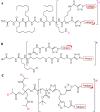Peptide conjugation via CuAAC 'click' chemistry
- PMID: 24284482
- PMCID: PMC6270195
- DOI: 10.3390/molecules181113148
Peptide conjugation via CuAAC 'click' chemistry
Abstract
The copper (I)-catalyzed alkyne azide 1,3-dipolar cycloaddition (CuAAC) or 'click' reaction, is a highly versatile reaction that can be performed under a variety of reaction conditions including various solvents, a wide pH and temperature range, and using different copper sources, with or without additional ligands or reducing agents. This reaction is highly selective and can be performed in the presence of other functional moieties. The flexibility and selectivity has resulted in growing interest in the application of CuAAC in various fields. In this review, we briefly describe the importance of the structural folding of peptides and proteins and how the 1,4-disubstituted triazole product of the CuAAC reaction is a suitable isoster for an amide bond. However the major focus of the review is the application of this reaction to produce peptide conjugates for tagging and targeting purpose, linkers for multifunctional biomacromolecules, and reporter ions for peptide and protein analysis.
Figures





 ) represent hydrogen bonding sites. (PDB: 1HPV [59] and 1ZP8 [53]).
) represent hydrogen bonding sites. (PDB: 1HPV [59] and 1ZP8 [53]).














Similar articles
-
Click to join peptides/proteins together.Chem Asian J. 2011 Oct 4;6(10):2606-16. doi: 10.1002/asia.201100329. Chem Asian J. 2011. PMID: 22043498 Review.
-
CuAAC: An Efficient Click Chemistry Reaction on Solid Phase.ACS Comb Sci. 2016 Jan 11;18(1):1-14. doi: 10.1021/acscombsci.5b00087. Epub 2015 Dec 21. ACS Comb Sci. 2016. PMID: 26652044 Review.
-
Recent Advances in Recoverable Systems for the Copper-Catalyzed Azide-Alkyne Cycloaddition Reaction (CuAAC).Molecules. 2016 Sep 5;21(9):1174. doi: 10.3390/molecules21091174. Molecules. 2016. PMID: 27607998 Free PMC article. Review.
-
Modification of Protein Scaffolds via Copper-Catalyzed Azide-Alkyne Cycloaddition.Methods Mol Biol. 2018;1798:187-193. doi: 10.1007/978-1-4939-7893-9_14. Methods Mol Biol. 2018. PMID: 29868960
-
Decoration of Coiled-Coil Peptides with N-Cysteine Peptide Thioesters As Cyclic Peptide Precursors Using Copper-Catalyzed Azide-Alkyne Cycloaddition (CuAAC) Click Reaction.Org Lett. 2018 Dec 7;20(23):7493-7497. doi: 10.1021/acs.orglett.8b03261. Epub 2018 Nov 8. Org Lett. 2018. PMID: 30407016
Cited by
-
Alkyne Ligation Handles: Propargylation of Hydroxyl, Sulfhydryl, Amino, and Carboxyl Groups via the Nicholas Reaction.Org Lett. 2016 Sep 16;18(18):4566-9. doi: 10.1021/acs.orglett.6b02088. Epub 2016 Aug 29. Org Lett. 2016. PMID: 27570975 Free PMC article.
-
Modified internucleoside linkages for nuclease-resistant oligonucleotides.RSC Chem Biol. 2020 Dec 8;2(1):94-150. doi: 10.1039/d0cb00136h. eCollection 2021 Feb 1. RSC Chem Biol. 2020. PMID: 34458777 Free PMC article. Review.
-
Design and synthesis of cyclic lipidated peptides derived from the C-terminus of Cx43 for hemichannel inhibition and cardiac endothelium targeting.RSC Med Chem. 2024 Dec 21;16(3):1289-1303. doi: 10.1039/d4md00850b. eCollection 2025 Mar 19. RSC Med Chem. 2024. PMID: 39829973 Free PMC article.
-
1,4-Disubstituted 1,2,3-Triazoles as Amide Bond Surrogates for the Stabilisation of Linear Peptides with Biological Activity.Molecules. 2020 Aug 6;25(16):3576. doi: 10.3390/molecules25163576. Molecules. 2020. PMID: 32781656 Free PMC article. Review.
-
Exploiting the MeDbz Linker To Generate Protected or Unprotected C-Terminally Modified Peptides.Chemistry. 2017 Sep 12;23(51):12484-12488. doi: 10.1002/chem.201703380. Epub 2017 Aug 15. Chemistry. 2017. PMID: 28741313 Free PMC article.
References
-
- Campbell N.A., Reece J.B. Biology. 6th ed. Pearson Education, Inc.; San Francisco, CA, USA: 2002. p. 1245.
-
- Curtius T. Ueber einige neue hippursaureanalog constituierte synthetisch dargestellte aminosauren. J. Prakt. Chem. 1882;26:145–208. doi: 10.1002/prac.18820260112. - DOI
-
- Fisher E., Fourneau E. Ueber einige derivate des glykokolls. Ber. Dtsch. Chem. Ges. 1901;34:2868–2879. doi: 10.1002/cber.190103402249. - DOI
-
- Merrifield R.B. Solid phase peptide synthesis.1. Synthesis of a tetrapeptide. J. Am. Chem. Soc. 1963;85:2149–2154. doi: 10.1021/ja00897a025. - DOI
-
- Vigneaud V.D., Ressler C., Swan J.M., Roberts C.W., Katsoyannis P.G. The synthesis of oxytocin. J. Am. Chem. Soc. 1954;76:3115–3121.
Publication types
MeSH terms
Substances
LinkOut - more resources
Full Text Sources
Other Literature Sources

